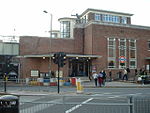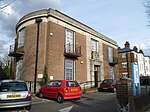Phoenix Cinema
1912 establishments in EnglandArt Deco architecture in LondonBuildings and structures completed in 1910Cinemas in LondonEngvarB from October 2017 ... and 3 more
FinchleyGrade II listed buildings in the London Borough of BarnetVague or ambiguous time from May 2022

The Phoenix Cinema is an independent single-screen community cinema in East Finchley, London, England. It was built in 1910 and opened in 1912 as the East Finchley Picturedrome. It is one of the oldest continuously-running cinemas in the UK and shows mainly art-house films. It is distinctive on East Finchley's high road by its large neon sign on the side of the building. Its patrons are Benedict Cumberbatch, Maureen Lipman, Mike Leigh, Ken Loach, Michael Palin, Bill Paterson and Mark Kermode. It is run by a charity as a community cinema.
Excerpt from the Wikipedia article Phoenix Cinema (License: CC BY-SA 3.0, Authors, Images).Phoenix Cinema
Fairlawn Avenue, London Hampstead Garden Suburb (London Borough of Barnet)
Geographical coordinates (GPS) Address Nearby Places Show on map
Geographical coordinates (GPS)
| Latitude | Longitude |
|---|---|
| N 51.5885 ° | E -0.1639 ° |
Address
Fairlawn Avenue
Fairlawn Avenue
N2 9PS London, Hampstead Garden Suburb (London Borough of Barnet)
England, United Kingdom
Open on Google Maps











